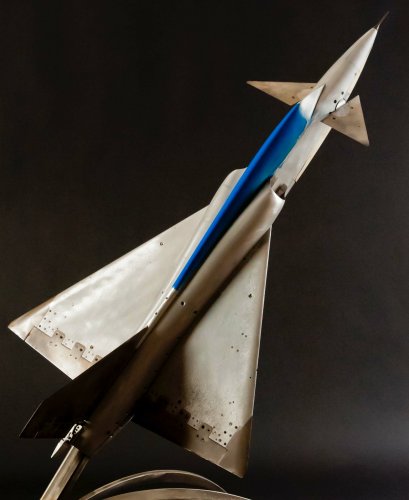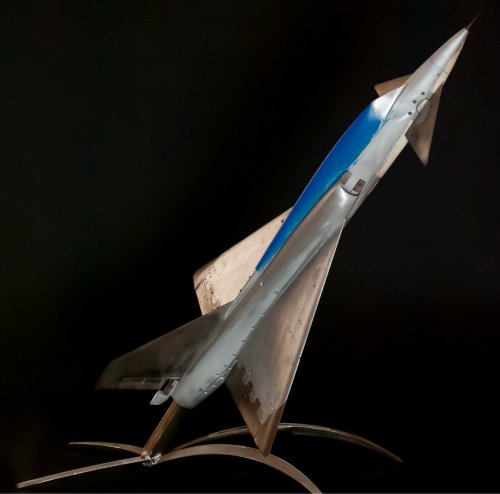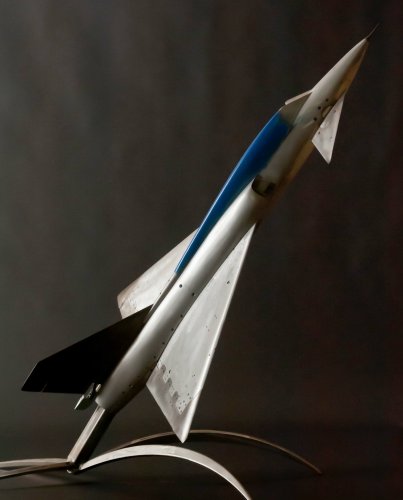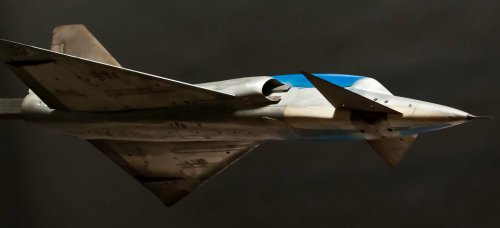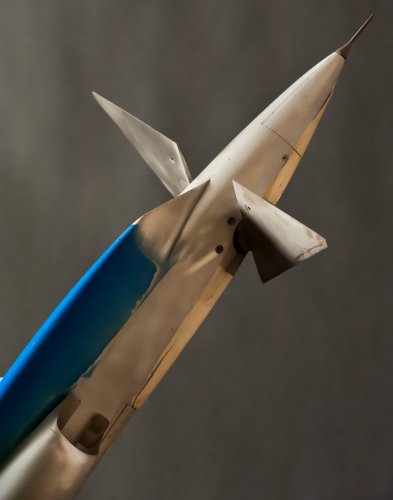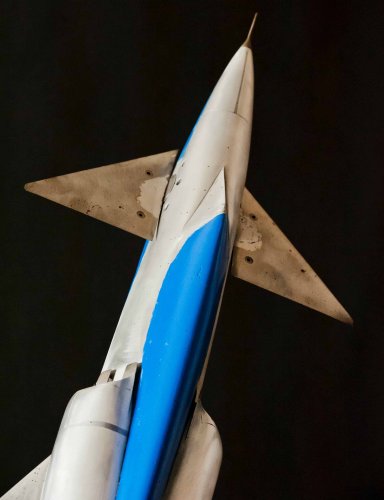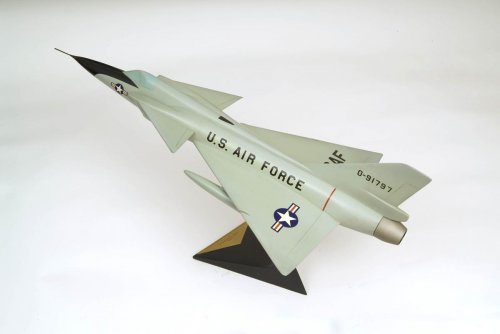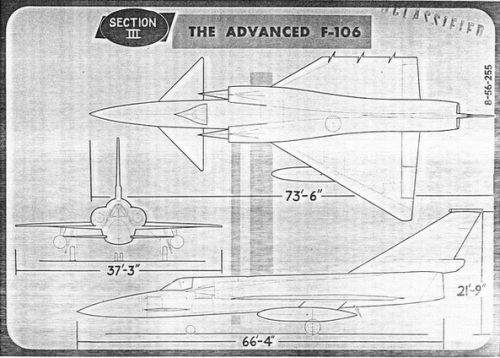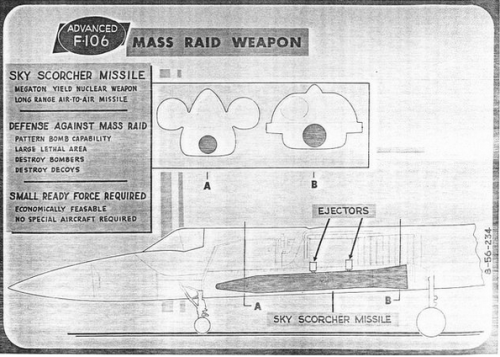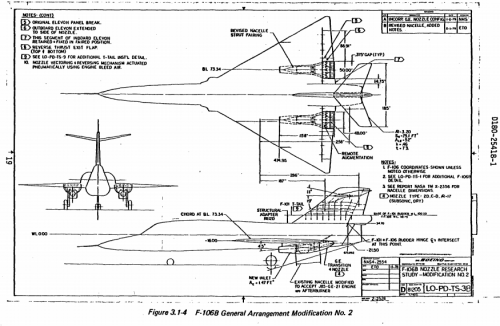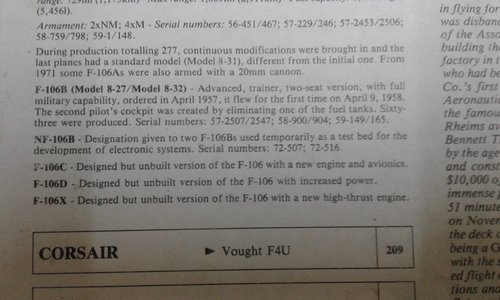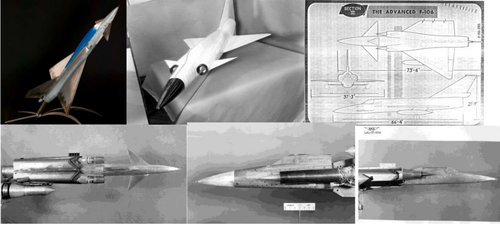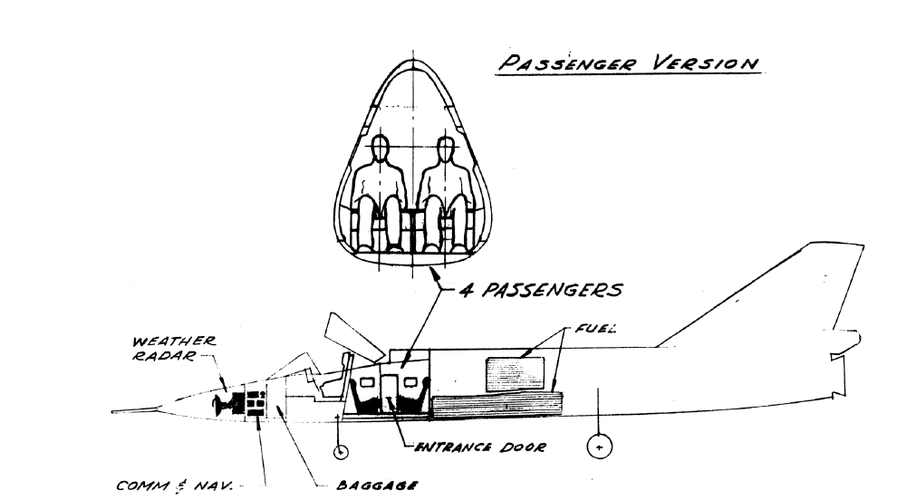You are using an out of date browser. It may not display this or other websites correctly.
You should upgrade or use an alternative browser.
You should upgrade or use an alternative browser.
Convair F-106 Projects
- Thread starter overscan (PaulMM)
- Start date
- Joined
- 27 December 2005
- Messages
- 17,706
- Reaction score
- 26,129
Thanks Greg.
http://www.collectair.com/f106xwindtunnelmodel.html
CONVAIR F-106X WIND TUNNEL MODEL
The fantastic, all-metal wind tunnel model pictured below was rescued from the Convair salvage yard in San Diego around 1963 by a Convair engineer; he was able to "free" both this model of the F-106X and a model of the F-111. The salvage yard at that time was open for four hours once a month, a real bonanza for employees searching for parts for home projects. I recall foraging in Cessna's Prospect plant scrap yard back in the 1950s and coming up with occasional treasures, but never a wind tunnel model!
This model of one version of the F-106X is in a large 1:20 scale and was undoubtedly used in Convair's Low Speed Wind Tunnel at speeds up to 300 m.p.h. This tunnel, located at Convair's (Convair Division of General Dynamics in 1961) plant, has been donated to the San Diego Air & Space Museum; information on the tunnel may be viewed by clicking here. Use the back arrow to return to this page. This tunnel (LSWT) is in current use by numerous manufacturers. The model was also likely used in the Lewis Research Center's transonic and supersonic tunnels as described in the 1969 NASA report, TM X-52585. In this report, a 1:20 scale model of the F-106B was sting mounted to study the flow field. You can study this report by clicking here. It is worth viewing as the F-106B test model is very similar to the F-106X model and the method of sting mounting is the same.
The model measures 41" from the tip of the pitot tube to the tail and the wingspan is 23"; both aluminum and steel are used for the model's construction. All materials and filler are original with the exception of the blue stripe/tape; no restoration has been made to the model. A few screws are missing, apparently the sole minor parts deficiency.
If you would like to research the history of the F-106, an excellent place to start is the F-106 Delta Dart Website.
The Convair F-106X was proposed in 1956 as a follow on configuration for the F-106; the "X" (Model 8-28/8-29) was to have more power with the JT4B-22 engine, rectangular intakes, canard layout and a longer nose with a 40-inch dish radar. The F-106X was proposed as an alternative to the Lockheed YF-12. The project was later re-designated F-106C/D, with "C" being the single-seat version, the "D" being the two-seat version. At one time the Air Force had considered acquiring 350 of these advanced interceptors, but the F-106C/D project was cancelled on 23 September 1958. Contemporary drawings and art work depicted the "X" as having the canard surfaces located alongside an elongated engine intake, unlike the F-106X model design offered here. There are, however, drawings from 1956 of an "X" version which is similar to the model's layout; you can view these report illustrations by clicking here. The F-106 became the prime ADC interceptor in the 1960s and a competent air-to-air fighter. There is mention of another proposal in 1967 of an F-106X design to fill the gap when the YF-12 fighter was cancelled; this F-106X didn't materialize. This later proposed design is not believed to incorporate the canard layout and would have been subsequent to the use of this model by many years.
This one-of-a-kind, metal wind tunnel model of the proposed Convair F-106X is a very rare find and is presented here for documentary and historical purposes.
http://www.collectair.com/f106xwindtunnelmodel.html
Attachments
- Joined
- 26 May 2006
- Messages
- 34,805
- Reaction score
- 15,693
- Joined
- 3 June 2011
- Messages
- 18,298
- Reaction score
- 12,115
circle-5 said:Factory model of the Convair F-106X IMI with canards, variable ramp intakes and a bigger engine.
(Photo by Chad Slattery)
Funny thing is one can begin to see the roots of the Convair Model 200 design here.
- Joined
- 3 June 2006
- Messages
- 3,093
- Reaction score
- 3,941
Robert Sullivan posted pictures showing wind tunnel models of the Convair Advanced F-106 Sky Scorcher at his flickr-site.
Link: https://www.flickr.com/search/?sort=date-posted-desc&advanced=1&text=sky%20scorcher%20f-106
Sorry, no time to attach the pictures to this post. :-\
Link: https://www.flickr.com/search/?sort=date-posted-desc&advanced=1&text=sky%20scorcher%20f-106
Sorry, no time to attach the pictures to this post. :-\
- Joined
- 26 May 2006
- Messages
- 34,805
- Reaction score
- 15,693
fightingirish said:Robert Sullivan posted pictures showing wind tunnel models of the Convair Advanced F-106 Sky Scorcher at his flickr-site.
Link: https://www.flickr.com/search/?sort=date-posted-desc&advanced=1&text=sky%20scorcher
Sorry, no time to attach the pictures to this post. :-\
Nice find my dear Rolf,
and the first drawing sent before by my dear Scott.
Attachments
KJ_Lesnick
ACCESS: Top Secret
- Joined
- 13 February 2008
- Messages
- 1,042
- Reaction score
- 111
Overscan,
Do you have any idea where it originated?Still not seen a reputable source for the Mach 5 claim.
XP67_Moonbat
ACCESS: Top Secret
- Joined
- 16 January 2008
- Messages
- 2,270
- Reaction score
- 533
Overscan,
I'm pretty curious about the F-106X Mach 5 rumor origin. It seemed to have popped up again yesterday on TGPTNW.
I'm pretty curious about the F-106X Mach 5 rumor origin. It seemed to have popped up again yesterday on TGPTNW.
- Joined
- 27 December 2005
- Messages
- 17,706
- Reaction score
- 26,129
crabanero said:What is TGPTNW?
Thank you!
Facebook Group "The Greatest Planes That Never Were".
ChuckAnderson
ACCESS: Confidential
- Joined
- 10 May 2006
- Messages
- 188
- Reaction score
- 45
Hi Everyone!
My Dad was in an F-106 unit (the 318th Fighter Interceptor Squadron) (ADC), at McChord AFB in the state of Washington.
Chuck
My Dad was in an F-106 unit (the 318th Fighter Interceptor Squadron) (ADC), at McChord AFB in the state of Washington.
Chuck
blackkite
Don't laugh, don't cry, don't even curse, but.....
- Joined
- 31 May 2007
- Messages
- 8,807
- Reaction score
- 7,675
Wow your father was in an F-106 unit!!ChuckAnderson said:Hi Everyone!
My Dad was in an F-106 unit (the 318th Fighter Interceptor Squadron) (ADC), at McChord AFB in the state of Washington.
Chuck
ChuckAnderson
ACCESS: Confidential
- Joined
- 10 May 2006
- Messages
- 188
- Reaction score
- 45
blackkite said:Wow your father was in an F-106 unit!!ChuckAnderson said:Hi Everyone!
My Dad was in an F-106 unit (the 318th Fighter Interceptor Squadron) (ADC), at McChord AFB in the state of Washington.
Chuck
Yes, and before that he was with an F-102 unit that was originally stationed at Paine Field AFB here in Washington state, that eventually went to the Philippines and South Viet Nam.
He worked in the fire control systems on both aircraft types, whose function I believe was to target hostile aircraft and fire the missiles.
Back in 1965, he (and his unit) took part in the William Tell competition at Tyndall AFB in Florida, where interceptor units from the USAF, ANG and RCAF had live fire exercises against what I believe were Firebee drones. The USAF aircraft were F-102s and F-106s, and the RCAF guys flew F-101B Voodoos.
Chuck
blackkite
Don't laugh, don't cry, don't even curse, but.....
- Joined
- 31 May 2007
- Messages
- 8,807
- Reaction score
- 7,675
My father belonged to an archibald unit as a lieutenant of the Japanese imperial army. Happily he didn't assign to the south front and avoided death in battle. He was a prisoner in the Soviet after Japanese loss, and was housed in a camp near Moscow. He was saying that the meal was very bad. ;D Sorry for off topic.
ChuckAnderson said:blackkite said:Wow your father was in an F-106 unit!!ChuckAnderson said:Hi Everyone!
My Dad was in an F-106 unit (the 318th Fighter Interceptor Squadron) (ADC), at McChord AFB in the state of Washington.
Chuck
Yes, and before that he was with an F-102 unit that was originally stationed at Paine Field AFB here in Washington state, that eventually went to the Philippines and South Viet Nam.
He worked in the fire control systems on both aircraft types, whose function I believe was to target hostile aircraft and fire the missiles.
Back in 1965, he (and his unit) took part in the William Tell competition at Tyndall AFB in Florida, where interceptor units from the USAF, ANG and RCAF had live fire exercises against what I believe were Firebee drones. The USAF aircraft were F-102s and F-106s, and the RCAF guys flew F-101B Voodoos.
Chuck
I really like the 318th markings, the big blue star on the tail of their aircraft. Their F-106s were beautiful, I have a 1/72 scale of it.
Last edited:
- Joined
- 26 May 2006
- Messages
- 34,805
- Reaction score
- 15,693
XP67_Moonbat said:Not sure if you guys have seen these yet. They're Boeing studies on non-axisymmetrical nozzles using an F-106B.
Enjoy.
http://forum.f-106deltadart.com/index.cgi?board=general&action=display&thread=3328
My dear AP67_Moonbat,
we forget this,with looks like T-tail ?.
Attachments
- Joined
- 13 June 2007
- Messages
- 2,172
- Reaction score
- 3,072
Looks like an Voodoo tail installed on the F-106. Odd....
Thanks! Mark
Thanks! Mark
NUSNA_Moebius
I really should change my personal text
- Joined
- 26 May 2012
- Messages
- 233
- Reaction score
- 135
Mark Nankivil said:Looks like an Voodoo tail installed on the F-106. Odd....
Thanks! Mark
Mentions it right there on the blueprint, along with the structural adapter.
- Joined
- 26 May 2006
- Messages
- 34,805
- Reaction score
- 15,693
jstar said:More here, in this post from 2017: https://www.f-106deltadart.com/piwigo/picture.php?/14484/category/491&slideshow=
Thank you Jstar.
- Joined
- 26 May 2006
- Messages
- 34,805
- Reaction score
- 15,693
F-106D probably a two seat version of F-106C
My dear Paul,
From the book; The American Fighters,that the F-106D Project had a more powerful engine.
Attachments
blackkite
Don't laugh, don't cry, don't even curse, but.....
- Joined
- 31 May 2007
- Messages
- 8,807
- Reaction score
- 7,675
Hi! Various air intake shape.
 www.f-106deltadart.com
www.f-106deltadart.com
Convair F-106X Conceptual Designs | F-106 Delta Dart Photo/Video Gallery
Convair F-106X Conceptual Designs
 www.f-106deltadart.com
www.f-106deltadart.com
Attachments
Last edited:
- Joined
- 3 June 2011
- Messages
- 18,298
- Reaction score
- 12,115
"F-106X (1968)F-106 "long nose" test aircraft and F-106X project
New radome and larger radar antenna. Modified FCS with lookdown capability. New AAMs. Competitor to YF-12. Added canards and revised intakes, and new engine with twice the power in the same size."
Any idea what 50,000lb thrust engine this would be?
- Joined
- 29 July 2009
- Messages
- 1,767
- Reaction score
- 2,455
I didn't see it mentioned, but the F-106 Eclipse project for towed launch concept for SSTO. https://www.f-106deltadart.com/eclipse.htm
Attachments
- Joined
- 16 April 2008
- Messages
- 9,581
- Reaction score
- 14,393
"F-106X (1968)F-106 "long nose" test aircraft and F-106X project
New radome and larger radar antenna. Modified FCS with lookdown capability. New AAMs. Competitor to YF-12. Added canards and revised intakes, and new engine with twice the power in the same size."
Any idea what 50,000lb thrust engine this would be?

I've seen a number of different engines associated with F-106X (which was never a single point design, AFAICT) but 50,000lb thrust seems unlikely for most of them.
According to "World's Fastest Single-Engine Jet Aircraft: The Story of Convair's F-106 Delta Dart Interceptor" by Col. Doug Barbier USAF (Ret.) - Get it, its a great book!!!

Several power plants were evaluated, including the P&W JT4B-23 engine, a JT4B- 22 with pre-compressor cooling, the Allison J89, two GE J79s, and two GE J93s.

Several power plants were evaluated, including the P&W JT4B-23 engine, a JT4B- 22 with pre-compressor cooling, the Allison J89, two GE J79s, and two GE J93s.
- Joined
- 19 July 2016
- Messages
- 4,259
- Reaction score
- 3,441
Has anyone seen layouts of the proposed 'C' variant?
Has anyone seen layouts of the proposed 'C' variant?
Yes - Pg79 of above book.
- Joined
- 25 January 2020
- Messages
- 1,279
- Reaction score
- 1,948
Has anyone seen layouts of the proposed 'C' variant?
I believe it is also found in Robert E. Bradley's "Convair Advanced Designs".
Has anyone seen layouts of the proposed 'C' variant?
I believe it is also found in Robert E. Bradley's "Convair Advanced Designs".
I believe you mean Convair Advanced Designs II

I have both it and the earlier referenced book. The F-106C image from the earlier is not in the latter.
- Joined
- 25 January 2020
- Messages
- 1,279
- Reaction score
- 1,948
Yes, my mistake.
blackkite
Don't laugh, don't cry, don't even curse, but.....
- Joined
- 31 May 2007
- Messages
- 8,807
- Reaction score
- 7,675
Attachments
- Joined
- 25 January 2020
- Messages
- 1,279
- Reaction score
- 1,948
Great find Blackkite! Here is what was written about it in the website:
An interesting read indeed, however, there are still many unanswered questions. Was the sonic boom taken into account? What was its range, and did it possess any in-flight refuelling equipment? Also, between which sites was it intended to operate? If its role was shuffling high brass officials to where they'd be needed most, I'm assuming that they would have been kept at the most strategic locations, but, if they were to be used in emergency situations, would they have been operated to and from dispersal fields? If yes, then the aircraft would have have to been modified to do so.Another one, which went much further, was the Convair Supersonic Command Transport project. It was initiated in 1958 and would have resulted in a conversion of regular, mass-produced F-106 Delta Dart interceptors into small-capacity passenger aircraft "for rapid transportation of Command Staff personnel in emergency situations in the minimum of time".
With modified F-106s, flying at Mach 1.8, officers could have been delivered across the U.S. territory in a matter of hours, assuming personal command in an emergency situation, or escaping one if need be. The aircraft would be modified by removing heavy and expensive radar, navigational, and fire control equipment and replacing it with four passenger seats and additional fuel tanks.
After some deliberation the idea shifted to using the B-58 Hustler bomber, which could maintain higher speed and carry more passengers. At the same time, the B-58 was considered as a testbed for various ideas related to commercial supersonic transport, but none of them saw the light of the day.
Firefinder
ACCESS: Top Secret
- Joined
- 5 October 2019
- Messages
- 1,040
- Reaction score
- 1,884
FOr the Sonic boom question...Great find Blackkite! Here is what was written about it in the website:
An interesting read indeed, however, there are still many unanswered questions. Was the sonic boom taken into account? What was its range, and did it possess any in-flight refuelling equipment? Also, between which sites was it intended to operate? If its role was shuffling high brass officials to where they'd be needed most, I'm assuming that they would have been kept at the most strategic locations, but, if they were to be used in emergency situations, would they have been operated to and from dispersal fields? If yes, then the aircraft would have have to been modified to do so.Another one, which went much further, was the Convair Supersonic Command Transport project. It was initiated in 1958 and would have resulted in a conversion of regular, mass-produced F-106 Delta Dart interceptors into small-capacity passenger aircraft "for rapid transportation of Command Staff personnel in emergency situations in the minimum of time".
With modified F-106s, flying at Mach 1.8, officers could have been delivered across the U.S. territory in a matter of hours, assuming personal command in an emergency situation, or escaping one if need be. The aircraft would be modified by removing heavy and expensive radar, navigational, and fire control equipment and replacing it with four passenger seats and additional fuel tanks.
After some deliberation the idea shifted to using the B-58 Hustler bomber, which could maintain higher speed and carry more passengers. At the same time, the B-58 was considered as a testbed for various ideas related to commercial supersonic transport, but none of them saw the light of the day.
Air Force stance on these is simple.
We will not go supersonic unless needed, and when we do we are telling all complaints from anyone including the FAA to FUCK OFF. That is all.
And honestly the sitaution where these thing will be use is one of them.
Similar threads
-
Convair (General Dynamics) F-106C Delta Dart
- Started by Pioneer
- Replies: 13
-
USAF ‘Improved Manned Interceptor’ (IMI) Program
- Started by Pioneer
- Replies: 78
-
Convair F-102 Delta Dagger Development and Derivatives
- Started by hesham
- Replies: 114
-
-
Flight Dynamics Laboratory BQM-106 "Teleplane"
- Started by Stargazer
- Replies: 7

